The Marie-Morgane
Basic Information
Anatomy
Ahes Dahut, Queen of Ys-Beneath-the-Waves
Mermay 1 - Anatomy and Facial Characteristics
by
Valentine
Genetics and Reproduction
The unique magical nature and one-sided gender distribution of the Marie-Morgane leaves the question of natural reproduction unresolved, as they do appear to possess human reproductive organs and secondary sexual characteristics. While theoretically possible, there is no known instance, to outsiders at least, of a natural born Marie-Morgane.
Population growth instead is parasitic in nature, relying on humans. Once a human is selected for the process, they will be captured or lured to the water. A Marie-Morgane possessing the ability to use the Oceansong will begin to sing in Truespeech, weaving the subject's name into the song. The song will change slightly as it progresses, altering reality as it is sung, wrapping around the subject, transforming them into a Marie-Morgane themselves. If the process is interrupted, the subject may regress over a period of time to their original form, although the song can be used again to repeat the process.
The gender of the human seems to have no bearing on the spell's conclusion, with both male and female victims ending in the same result, becoming a female Marie-Morgane. Hair length and secondary sexual characteristics may vary, but the results do not appear to have any relation to the subject's original gender. Perhaps most shocking to the victim, the change also includes their voice, which carries over to their internal, telepathic projection as well. No successful method has been established to determine the subject's original gender. Likewise, there seems to be no indicator to predetermine tail and fin colour or shape.
Another aspect of the Marie-Morgane's reproduction seems to be tied directly to their curse, a fact which contributes to the uncertainty of the subject of natural reproduction. A human attempting to copulate with a Marie-Morgane is similarly transformed, as if by Oceansong and with the same results.
Growth Rate & Stages
For the most part, the Marie-Morgane only have one physical stage after their transformation. However, there are two exceptions. Young children are susceptible to the Oceansong, transforming into a Marie-Morgane at the same level of development as their human forms (although gender transformation still occurs). These subjects continue to develop until shortly after reaching sexual maturity, at which point aging and development stops. On the other side, an older victim will actually regress in physical age to reach this point.
Ecology and Habitats
Archdruidess Rozenn tends to the Nemeton of Ys-Beneath-the-Waves
Mermay 5 - Ecology and Habitat
by
Valentine
Dietary Needs and Habits
Unlike many Sidhe or Re Vihan, the Marie-Morgane do actually require food. Their food sources generally come in 3 forms; Hunting, farming and raiding. Armed with nets and fishspears, the Marie-Morgane have become skilled aquatic hunters, chasing down all manner of fish and crustaceans. More recently, they have begun to cultivate kelp, fish, shellfish and other commodities in farms, after much trial and error. Lastly, they will frequently attack surface vessels and settlements, often when a Marie-Morgane misses her life on the surface and the food she once enjoyed. Surface food is highly prized by the Marie-Morgane, and some colonies have begun to trade with relatively friendly settlements along the Ar Mor.
Biological Cycle
After hearing the Oceansong and completing their transformation, a Marie-Morgane's physical age is frozen in place, with the two exceptions detailed above (Growth Rate & Stages).
Additional Information
Social Structure
Originally humans, the Marie-Morgane have imported a great deal of their social structure from their former lives, with some noteworthy exceptions. Arranged as a kingdom, Queen Ahes Dahut, the first of the Marie-Morgane and Princess of Ys sits at the top as the absolute and undisputed monarch, holding dominion over the seas themselves. Considering feudalism a form of slavery, Ahes abolished the system. To further the survival of the city, she placed an ere-hud in the Oceansong to ensure that the Marie-Morgane would put their efforts to the betterment of the clan as a whole. All Marie-Morgane are required to contribute their efforts to the culture, civic betterment and defense of Ys-Beneath-the-Waves. However, the ere-hudis clear to not extinguish personal benefit or motivation, and court intrigue is fairly common as individuals jocky for Ahes' favour.
Unlike the land-dwelling humans and Sidhe, the Marie-Morgane have no noble classes, instead basing their division of authority based on skills. This comes as a shock to the newly transformed, finding their social class tripped away, for better or worse.
In order to mitigate potential harm to the clan or the individual, newly transformed Marie-Morgane have restricted privileges, which are slowly removed as they become more adjusted to their physical forms and new culture.
Bards are especially prized and often receive preferential treatment because the Magik of the Marie-Morgane is inherently tied to music. While all Marie-Morgane have the potential to master NameMagik, bards are more easily able to do so on short notice, making them invaluable for the protection of the clan and recruitment of new members.
Domestication
An Ubarite Nobleman discovers the dangers of imprisoning a powerful Marie-Morgane
Mermay 8
by
Valentine
Isra and Maireid
Uses, Products & Exploitation
Less common than outright slavery, some have decided that various parts of the Marie-Morgane, such as tears, fins or scales, are potent magical remedies for a variety of ailments. They are almost always wrong, and the Marie-Morgane are relentless in their quest to punish the guilty parties, even making contracts with Redcaps or sending the Merrow to strike at inland targets.
Facial characteristics
For the most part, the Marie-Morgane have facial features indistinguishable from humans, but they have several noteworthy external features that differentiate them, The most notable of these are their prominent "ear-fins" which consist of colourful, rib-like veins, with translucent webbing stretched between them. These ear-fins are identical in colour to the Marie-Morgane's tails. Additionally, like other creatures of Faerie, they will sometimes have hair and eye colours that are not found in mortals, which may take on the distinctive shimmer of glamour, especially when in Faerie.
Geographic Origin and Distribution
The vast majority of Marie-Morgane live in Ys-Beneath-the-Waves and along the Ar Mor. A few colonies and individuals exist away from the peninsula, but they are smaller in number. Inherently social creatures, the Marie-Morgane will only venture far alone in rare circumstances.
Average Intelligence
The Marie-Morgane are as intelligent as humans and some kinds of Sidhe.
Perception and Sensory Capabilities
The Marie-Morgane possess senses on par with most Milliget, with their hearing and sight above those of normal humans. Their senses are significantly amplified under water. The webbing of a Marie-Morgane's ear-fins of appear to pick up vibrations in the water, relaying the information to their brains. As such, they lack external ear cavities.
Marie-Morgane appear to be able to communicate telepathically with each other, as well as projecting themselves to other species. While no mouth movement is required for this type of communication, many Marie-Morgane, especially younger ones, do so out of habit.
Symbiotic and Parasitic organisms
All Marie-Morgane were, at one point, human and further population growth relies on human reproduction. The Marie-Morgane abhour slavery and feel that humans with desirable new experiences and skills are preferable for the strength of the clan. Therefore, they focus of luring and capturing "free" humans, rather than attempting other methods such as maintaining a captive colony.
The Marie-Morgane are also responsible for the Isfont, a type of Slaugh. Horrific mutated abominations, these creatures are exiled to the Abyss and spoken of in fearful and hushed tones. The creation of these identity-less monsters is reserved for only the most serious of crimes such as serial murderers, violent rapists and slavers. These are created by weaving VoidMagik into the Oceansong, destroying the subject's Truename and casting them out. Because of its seriousness and finality, it is only used against the most abhorrent and unrepentant that would continue to threaten the city if left alive. The Marie-Morgane despise the Isfont and send them into the Abyss.
Civilization and Culture
Naming Traditions
The Marie-Morgane generally keep their human names, although former males will usually choose to adopt the feminine form after a time. This is in large part due to the nature of the Oceansong, which magically ties their Truename in with the curse.
Major Organizations
Beauty Ideals
Generally a vain race, the Marie-Morgane operate on two spectrums of ideal beauty. The first in in choosing their subjects for Courtship, the second in assessing their own beauty. In humans, youth and virility are prized, as is physical fitness and pleasant features. Among themselves, appearance is highly valued, and the Marie-Morgane go to great lengths to show themselves off. Vibrant tails and fins are prized along with more conventional criteria.
Gender Ideals
Gender and the Marie-Morgane
Beladore, Dominique and Yannic.
Despite being a biologically monosexual race, gender is a fluid concept for the mermaids of Ys-Beneath-the-Waves
Despite being a biologically monosexual race, gender is a fluid concept for the mermaids of Ys-Beneath-the-Waves
Courtship Ideals
The curse of the Marie-Morgane has greatly affected their view of courtship, especially where concerning humans, and it has become central to their culture. Romantic partnerships are common among the Marie-Morgane themselves as well as with humans they find attractive. The latter usually ends with them going their separate ways, the human either abandoned, drowned or becoming Marie-Morgane, at which point the continuation of the romance relies largely on the individuals themselves. Courtly and tragic lovestories are extremely popular among the Marie-Morgane, who identify with the concept of transcendent, but often unconsummated love. A popular "game" among the Marie-Morgane, especially those unable to use the Oceansong, involves initiating such romances to trigger one of the aforementioned ends, then break off the relationship, sometimes leaving their would-be-lover a corpse or a very confused mermaid. Still, many romantic partnerships do transcend this trend and continue after the former human becomes Marie-Morgane.
Courtship with a human, even under these circumstances, follows a fairly rigid process, although many of the stages are easily missed by the unobservant human recipient. The first and second stages are a attraction, often a glance, followed by admiration and worship from afar. Eager Marie-Morgane are quick to assume that a fleeting look was reciprocated, although this is not always the case and the relationship is rather one-sided. This stage lasts for an extended time, followed by a passionate declaration of love, ideally followed by rejection by the subject. Marie-Morgane are especially fond of using their curse as a reason that the lovers can not be together, although they leave out most of the relevant details as to its nature, or the classic "we are from different worlds" line, which is considered the proper response. The wooing is then re-established, often with lamentations of lovesickness. Poetry and song is often written during this stage and is quite popular among the Marie-Morgane. The Marie-Morgane often set their lovers on some task to prove their love, which often ends in their death as a result of a poorly thought out challenge. The courtship usually ends with this or the subject's transformation into a Marie-Morgane.
Relationship Ideals
The idea of Courtly Love continues to largely define the relationships of the Marie-Morgane, who relish the idealized concepts present in the art form. Due to the nature of their curse and their immortal lifespans, relationships between humans and Marie-Morgane are relatively short, one way or another. However, sometimes these courtships blossom into longtime partnerships, either from afar until the human's death, or continuing after their transformation into Marie-Morgane. Long-term relationships between the Marie-Morgane are not uncommon, even lifelong partnerships. However, the nature of Marie-Morgane reproduction necessitates the bringing in of new blood, so polyamorous relationships are not stigmatized, but often encouraged.
Average Technological Level
The technological level of the Marie-Morgane has largely been attained erratically through acquisition, rather than invention, both by raiding passing ships and adding knowledgeable persons to their numbers. As such, their technology is astoundingly lopsided and filled with gaps. They are incredibly skilled in magic and weaponry, creating weapons and artifacts that are equal in many ways to the those of the Tuatha de Danaan. In others, such as farming, they are far behind humanity, stuck at an early iron-age level of sophistication, which has forced the population to maintain its slow, but growing trend, well below the suspected ability of Ahes's powers. Architecture is a rising skill in the population, but is largely focused on magical construction within Ys itself as are other forms of craftsmanship such as pottery and weaving. Refined products from Faerie and mortal craftsmen are highly prized by the Marie-Morgane, who employ a robust trade-education system to spread this knowledge from their limited sources.
Major Language Groups and Dialects
All Marie-Morgane are able to hear and project themselves telepathically immediately after their transformation, regardless of their known languages. When speaking audibly, Brezhoneg is the most commonly known language, simply because of geographic convenience and the majority of native speakers. The Marie-Morgane are avid linguists, as new languages can add new variation into their songs, and newly acquired speakers are often swarmed by admirers hoping to learn from them.
Truespeech is exceptionally valued, as it allows a Marie-Morgane to use Name Magik and is crucial in the Oceansong. Speakers are generally highly regarded in society and serve in positions of great honor.
The Marie-Morgane possess a written language, a heavily-altered variation of Ogham script generally corresponding to Truespeech. These runes are often luminescent and are used to record spells, songs and cultural notes. A corrupted variant is used for more mundane writing and to communicate with other races. Unfortunately, few mortals or Fae can read this language, making its use generally impractical. Human written languages are usually met with disinterest and rarely travel beyond the initial holder of the knowledge once their meanings are translated.
Common Etiquette Rules
The Marie-Morgane place little value on proper social etiquette when dealing with humans, although they take great offense if they are not treated with it themselves. Among their own kind, it is proper to treat each other as equals and attempts to instill human ideals of class stratification is considered offensive. Proselytizing, while not outright banned, is discouraged, especially where it relates to the Southern Church, a sore subject among many of the Marie-Morgane. Claiming a mortal target for Courtship is generally seen as a first-come, first-serve system and moving on another's target is considered to be in bad taste.
When meeting another Marie-Morgane or a member of another Tuath, the Marie-Morgane will position themselves at head-height of the other they are speaking to. This extends to creatures both larger and smaller than the Marie-Morgane, a sign of equality between them.
Common Dress Code
The Marie-Morgane tend to wear light clothing, if any at all, as no stigma is placed on nudity among them and is even generally encouraged. When clothing is worn, it usually amounts to little more than a brassiere or short top, although personal preference still dictates their decision. They are exceptionally fond of jewelry, however and will wear it frequently. The exception to their disinterest in clothing is armor, which can range from the preferred simple breastplate and vambraces, to full plate. Some exceptionally dedicated warriors even have developed barding for their tails. Sharing the Fae allergy to Iron, this will often be substituted with other materials.
Generally, it is more common for newer Marie-Morgane to be seen wearing a lot of clothing while they are still uncomfortable with their new forms. Some eccentric Marie-Morgane, often Mages, will continue to wear flowing robes made of a light material that handles well in the water. The most common material is bysuss, used to weave sea-silk, a technique which the mermaids have begun to perfect, allowing for more clothing options.
Culture and Cultural Heritage
The unique nature of the Marie-Morgane has led to their culture adopting a variety of different cultural values and expressions as they acquire new members. Generally however, they follow a few broad tenets. Despite the reality of the Marie-Morgane being cultural scavengers and biological parasites, they hold themselves up as a self-sufficient race, generally superior to land-dwelling mortals. Individual skills and abilities are valued much higher than formal social status, and all are expected to share their knowledge and contribute actively to the betterment of their clan.
The Marie-Morgane celebrate life and maintain an active and inquisitive lifestyle, highly valuing music and stories as cultural treasures. Bards are especially prized and sought out. Courtly love is extremely popular among the Marie-Morgane and is held up as the ideal standard.
The Marie-Morgane find slavery abhorrent, holding it as an unforgivable offense. Slaver ships are destroyed without mercy, the slavers killed or transformed into the horrific Isfont. Slaves are either welcomed into the clan or, significantly more commonly, set to drift towards shore, often with guidance from unseen Marie-Morgane.
The Marie-Morgane are aggressively territorial and do not hesitate to defend their perceived domain with lethal force.
Common Customs, Traditions and Rituals
The Courtship Ritual of the Marie-Morgane is an important cultural custom and is seen as a right of passage in the clan, fully embracing their new lives. Ostensibly, this is to grow the clan and bring in new and valuable skills, and requires a good deal of observation, assisted by the extended "longing-from-afar" stage of the ritual. Oftentimes, if a subject is not deemed desirable individually or beneficial to the Clan, the Courtship will end here. That said, younger Marie-Morgane will often eagerly justify their choices based on physical attraction alone, which has come to be viewed as acceptable, although not expressly encouraged. Following a successful Courtship that ends in an Oceansong or other method of transformation, the Marie-Morgane and her chosen lover are brought before Ahes and a ceremony welcomes the Marie-Morgaine into full acceptance and the newcomer into the clan. This is similar to a wedding ceremony, but there is nothing to prevent the participant from repeating their courtship with a new partner in the future. The newcomer is often restricted to Ys for a time to adjust to their new life and prevent attempts to return to their old life.
The largest ceremony is the Lamentation of Ys, commemorating the city sinking into the sea and the beginning of the race. This is marked by a formal procession through the city with lights, accompanied by dirges and mournful ballads. Upon reaching the Great Palace, the mood changes, becoming one of rebirth and celebration. This marks one of the few times where outsiders are allowed safe passage into the city, although they may make themselves targets for Courtship in doing so and many do not leave, instead being encouraged into joining the clan before the end of the festival.
The other major festival is the Coming of the Storms, a harvest festival-like event, celebrating the beginning of hurricane season, when ships and coastal settlements are shattered by the rough seas and storms, considered a great boon to the Clan. This ceremony is marked by a martial procession, dancing and music as well as a great feast. This is often followed by ritual combat and raids during the height of the storm. It is considered the most dangerous time for human ships and settlements.
The Lamentation of Ys
The Lamentation of Ys
by
Valentine
Clemence d'Auverge takes part in the Pardon during the Lamentation of Ys, where the Marie-Morgane commemorate the sinking of the city.
Common Taboos
The Marie-Morgine are defined by Ahes's Ere-hud and their species and society are built around the constrains of the curse. By pushing the boundaries of her curse, Ahes began the race and established Ys-Beneath-the-Waves. The Oceansong actually passes the curse along to those subjected to it and changes to their physical traits are merely a side-effect of the original curse. Likewise, the Ere-hud, as modified by Ahes, is also passed along to any who attempt to violate its conditions, resulting in a transformation as if the Oceansong was used.
Ahes's Ere-hud, and by extension the Oceansong contains the following conditions, usually in the form of a poem: That she remain forever bound to Ys, never again to walk on dry land, desired, yet never again to feel the loving touch of Man. Breaking or lifting the curse is impossible, but Ahes was able to manipulate its meaning to gain some relief from the curse by creating the Marie-Morgane. The taboos of the Ere-hud are as follows:
Remain Forever - A Marie-Morgane is functionally immortal, unaffected by time. They can still be killed with disease or violence, but they are unaffected by aging. Ys itself operates in a pocket of Faerie-time.
Bound to Ys - Initially meant to contain her within the city, Ahes has altered this to instead mean loyal to Ys, unable to serve another master to its detriment. Likewise, it means the fate of a Marie-Morgane is tied to that of the city.
Never again to walk on dry land - While the vast majority of Marie-Morgane are simply forced to remain in water (they can survive on land for short times and breath air, but must be wet. Drying out will kill them. Some powerful spellcasters, such as Ahes herself and the Merrow, can actually transform their tails into feet and walk on land for extended, but not indefinite times. However, they leave behind puddles of water beneath their bare feet, a small cushion of water preventing them from actually stepping on dry land.
Desired - Originally meant to drive Ahes deeper into despair by making her desired, yet unattainable, unable to satisfy her physical and emotional needs, all Marie-Morgane develop similar attributes of conventional beauty.
Never again to feel the loving touch of Man - The final part of the Ere-hud holds several meanings, preventing the Marie-Morgane from interacting romantically. This applies both to men and humankind in general, thus altering those under the geas into female Marie-Morgane, therefore skirting both interpretations. This operates as a defense mechanism, preventing the calamitous consequences of breaking the Ere-hud by rendering the act physically impossible to complete.
The Marie-Morgane also share a serious allergy to cold iron similar to the Fae, a result of their magical nature and constant exposure to Faerie-magik.
A strong social taboo is placed against slavery.
History
The Marie-Morgane's story begins with the fall of Ys and the transformation of Ahes Dahut. For two hundred years, Ahes was alone with her despair in the dead city, abandoned by the surface and condemned to remain below the waves. As time passed, she began to test the limits of her curse and slowly, but surely, amass power over it, controlling aspects of the sea around her. It began small, but her mastery grew as she exploited the loopholes. Determined to change her fate of unending loneliness, she turned her attention to NameMagik, succeeding in transforming her first subject, a druid on the run from the Southern Church. With a formal teacher, her powers expanded and she began to grow her small fiefdom. At first, it began slowly, transforming those who fell overboard on ships or were swept out to sea, but as her power grew, so did her confidence, launching raids on ships and coastal communities. The Marie-Morgane began to acquire skilled warriors, artisans and magik users, and the numbers to begin rebuilding Ys.
Ahes has harboured a mutual vendetta against the Southern Church for some time, and treats the Faithful with great suspicion, a trait which has been unconsciously passed down in the Oceansong and reinforced by the string of crusades, excommunications and attacks directed against Ys-Beneath-the-Waves.
In more recent times, Ys has emerged as a powerful force, openly operating along the Ar Mor and in Faerie.
Common Myths and Legends
The Sinking of Ys has taken on a very different interpretation than the version taught by the Southern Church, placing Ahes as a hero standing up against foreign domination and social oppression, and with Ys as a beacon of light in a dark storm.
Interspecies Relations and Assumptions
The Sidhe
- The Marie-Morgane and the Sidhe have fought several wars in recent centuries, often triggered when both sides attempt to abduct a person of interest, such as a skilled bard. The Queens of Summer and Winter have had to begrudgingly admit that the power of Ys may be equal to theirs. It is not uncommon to see Marie-Morgane operating around Faerie-Isles or in Goblin Markets, and the two trade frequently.Bediz
- Contrary to human belief, the Marie-Morgane are not overtly hostile to humanity, once being human themselves and relying on the species to grow their own culture. However, their aggressive territorialism and an incomplete view of the Courtship has given the Marie-Morgane a reputation of piratical raiders and homicidal sirens eager to drown men who fall for their charms. The Church feeds this distrust with its propaganda, using the fall of Ys as a morality tale and branding the Marie-Morgane as demonic succubi. They are often confused with other types of mermaid, such as Selkies, the nearly feral Finfolk or even the gigantic Stormmaids, which leads to more confusion. However, some communities, especially in Lower Briezh, have friendly relations with their Marie-Morgane neighbors.The Fomorians
The Daughters of Ker-Ys and the Sea Clans have a long, and often tense history, stretching back to before the Beacon City fell beneath the waves. Having long, but intermittently, raided the Northeast of the Great Kingdom of Kernev, the Fomorians had battled Ahes's father, King Gradlon Mwar, in the War of the Erlking, and were renowned for their ferocity and battle prowess. When Ker-Ys fell and the Kingdom crumbled, Ahes could only watch from her sunken prison as raiders of all kinds pillaged her once great Kingdom. For a time, the few Fomorians who entered the region were keen to avoid Douarnenez Bay for that was Ahes's realm, and her wrath would fall on any who crossed over her city. As the Finfolk began to move against the Beacon City, more and more ships passed unharmed, and the bay became a frequent target of raids and battles. The 8th and 9th Centuries saw an explosion of activity in the region from both Ys-Beneath-the-Waves and the Fomorian Sea Clans of Tevenn Du. In 736 SI, the Marie-Morgane launched their infamous Odet Raids along the West and Southern coasts and rivers, seizing people, food and goods in their most brazen move against the Peninsula. In the Northeast, the Fomorian warlord Hastings Fireforged set his sights on conquering the divided kingdoms, eventually taking control of the entire Armorican Peninsula in 811 SI. It was inevitable that these two forces would collide. The Daughters of Ys would sink Formorian longships, taking prisoners and goods, while the Formorians would take the Marie-Morgane as slaves or kill them during skirmishes. Sometimes, the two groups would hit the same coastal settlement in a raid, adding a level of chaos that heightened both their reputations. This continued well past when Hastings was defeated by Dug Alan II in 841 SI. In the centuries after this tumultous era, both the Marie-Morgane and the Sea-Clans stabilized. Both continued to raid shipping, coastal settlements and each other, but the two groups, tied to the sea in their own ways, often found common ground, forming a symbiotic relationship of semi-coordinated raids of opportunity, with Marie-Morgane following the distinctive silhouette of the Northern Longships to raid settlements. The two groups occassionally trade information and goods, but a continued slave culture among the Fomorians prevents further official communication, and the two groups sometimes come to blows. There is a small population of former Fomorians among the Marie-Morgane, which has led to some softening of relations as the two focus on a common enemy: The dreaded Finfolk.Other Merfolk
- Selkies - The Marie-Morgane view the sealmaidens as their kinfolk, sympathetic allies against the world of Man. The Selkies on the other hand, think that the Marie-Morgane are far too aggressive, expansionist and much to close to human for comfort. For their part, the Marie-Morgane often will rescue enslaved selkies as part of their crusade.
Genetic Ancestor(s)
Lifespan
Immortal. Like the Sidhe, Marie-Morgane are ageless, although they can be killed by violence or disease.
Conservation Status
The numbers of the Marie-Morgane have grown significantly since the fall of Ys, although they remain a relatively small group compared to Humanity, the Sidhe or the Re Vihan. The hostile environment of their home, their unique biology and aggressive territoriality poses a number of threats to their existence as a species, including tensions with other sapient groups. The Southern Church deems their very existence heretical and actively encourages their capture or extermination. As a result, the Marie-Morgane are treated with hostility in many coastal communities. Despite this, their numbers are generally stable and consistently trend towards the positive, even in times of calamity or active crusade against them.
Average Weight
80 kg
Average Length
2.3 M
Average Physique
All Marie-Morgane (with the exception of children) take the form of beautiful women, but are slightly stronger and more agile than their human counterparts.
Body Tint, Colouring and Marking
The Marie-Morgane will retain the skin colour of their human forms. Generally, this also applies to hair and eye colour, but there are numerous exceptions to this, depending on how they react to the Oceansong. Their tails are covered in brightly coloured scales, although black, white and grey variants have also been reported. These tails are sometimes patterned.
Related Ethnicities
Related Materials


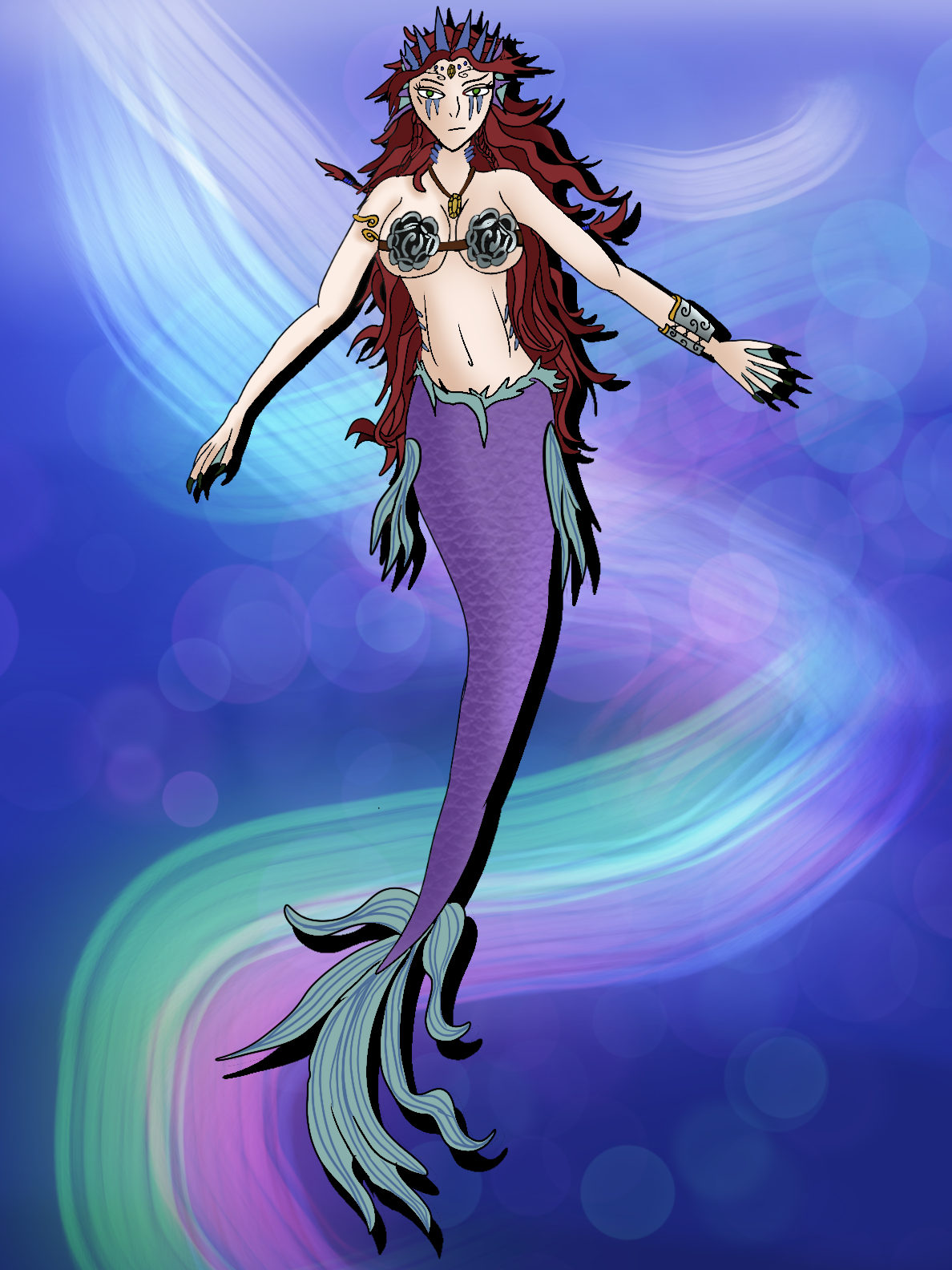
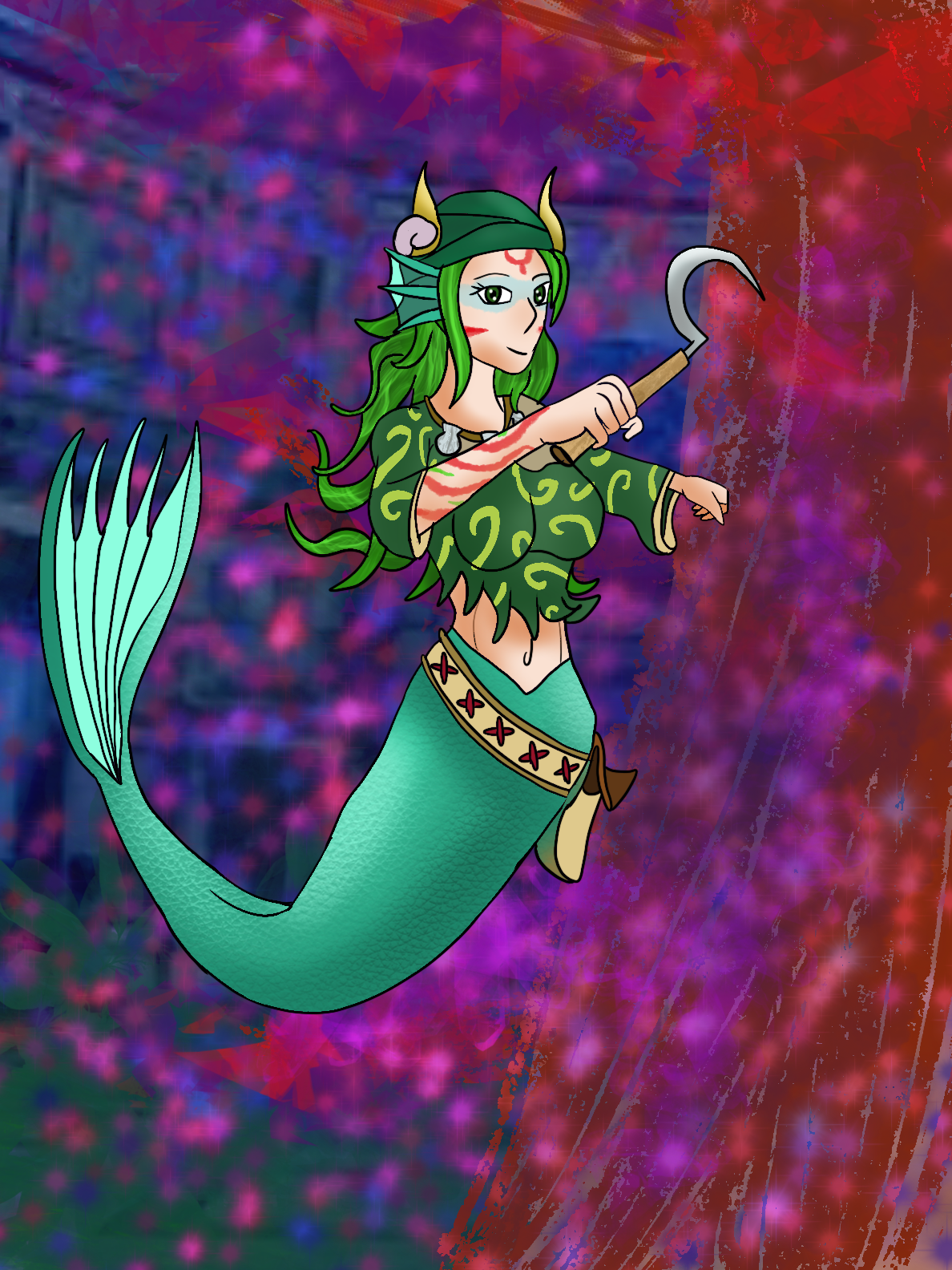
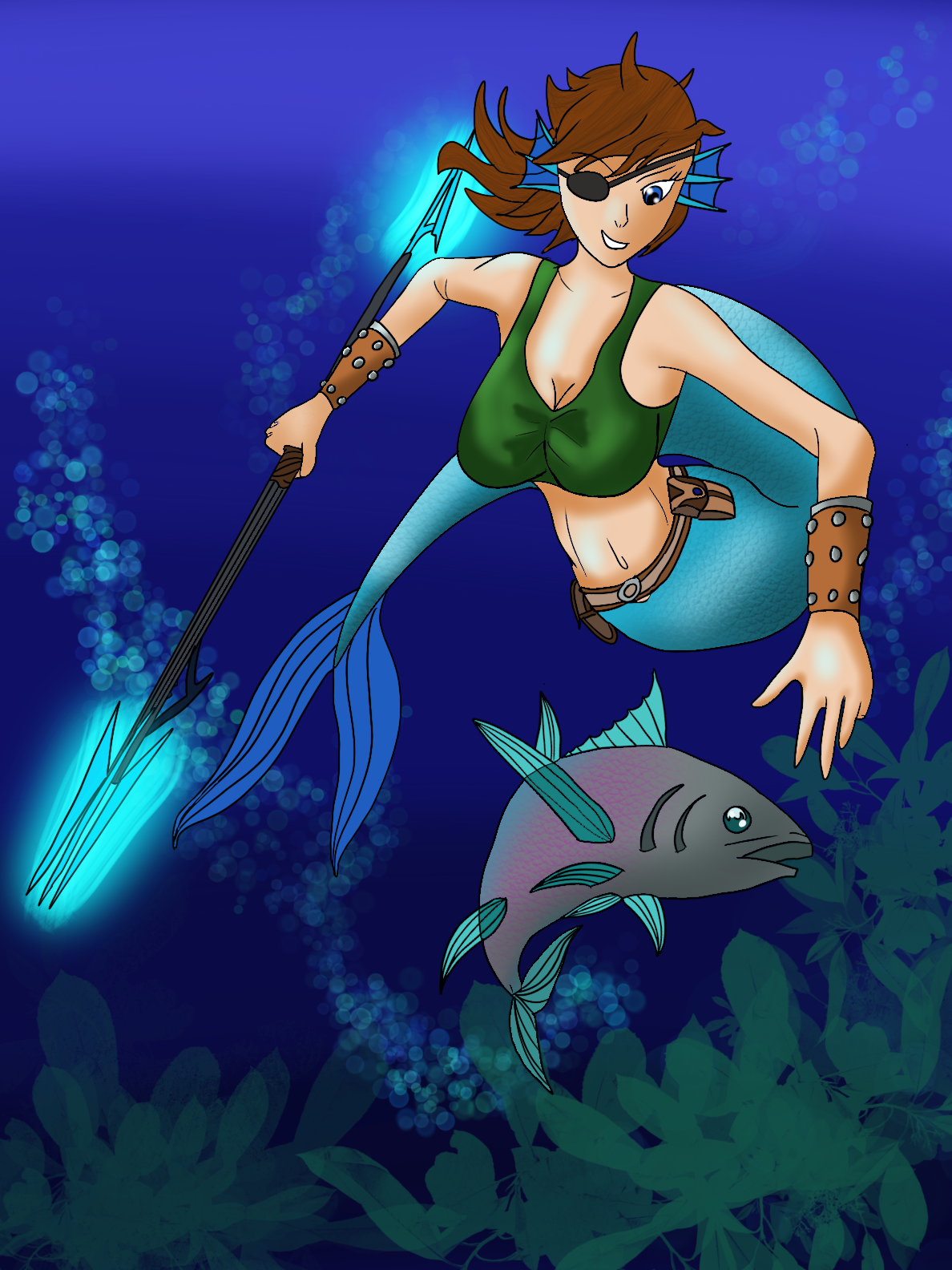
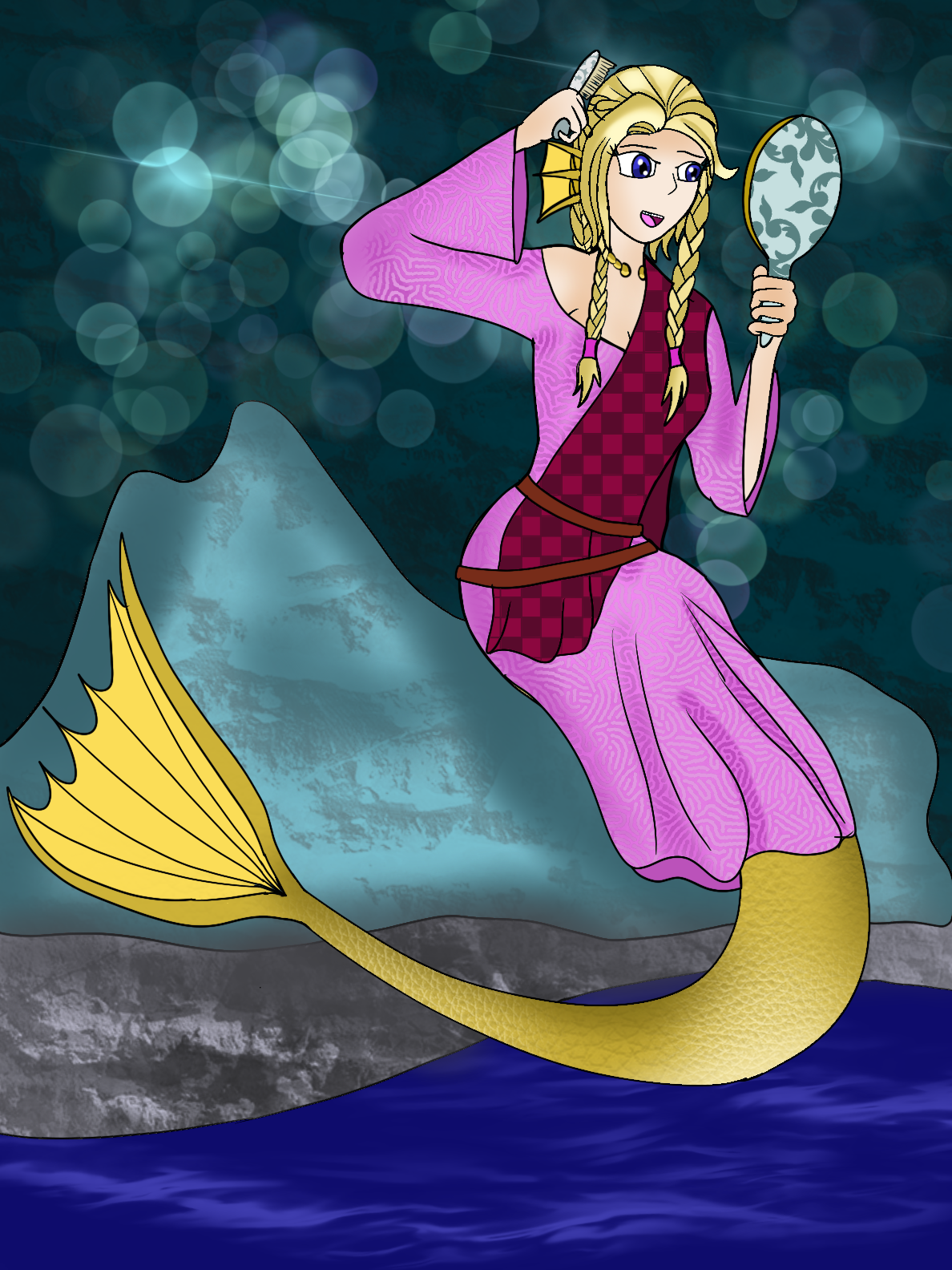
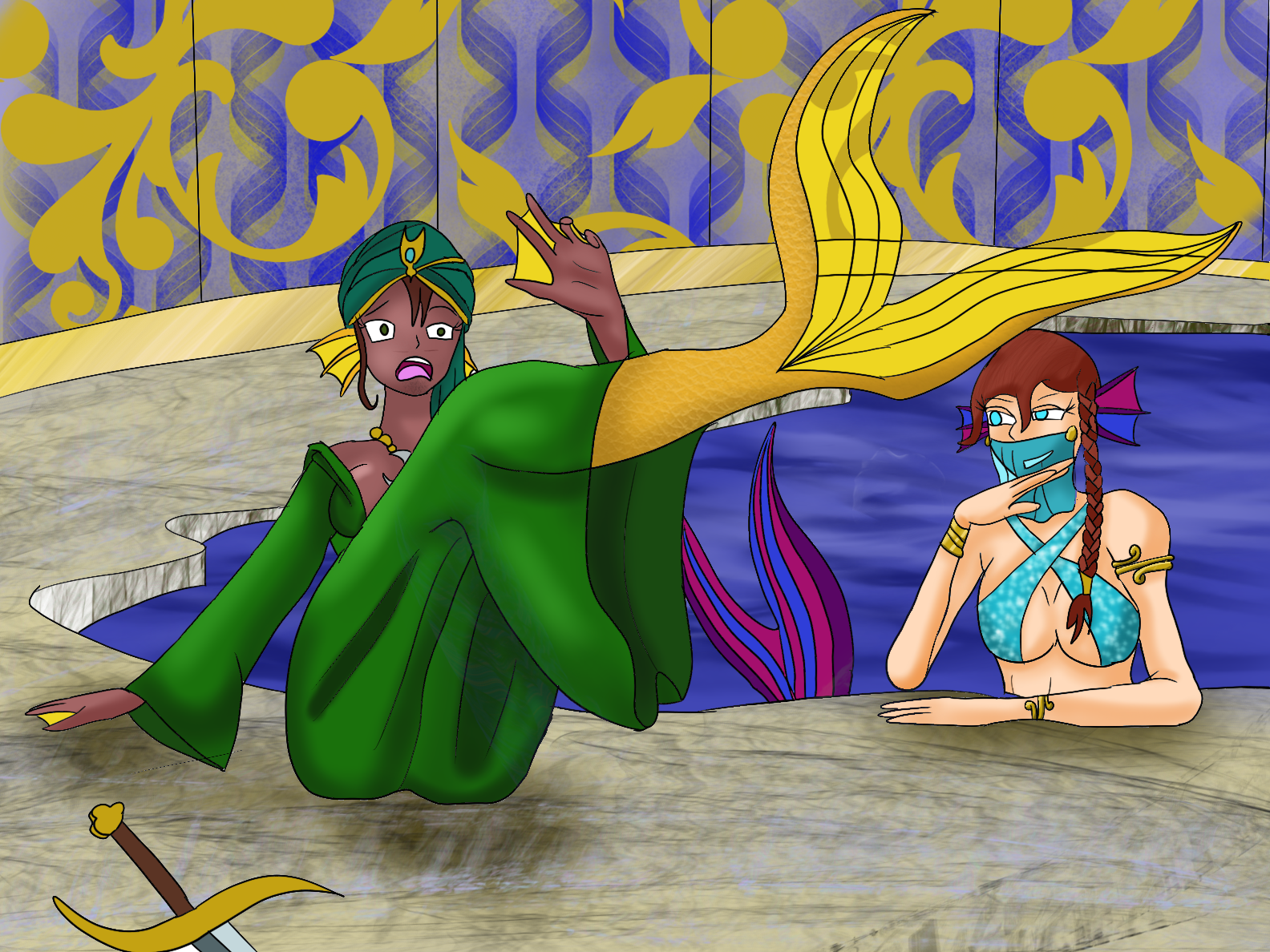
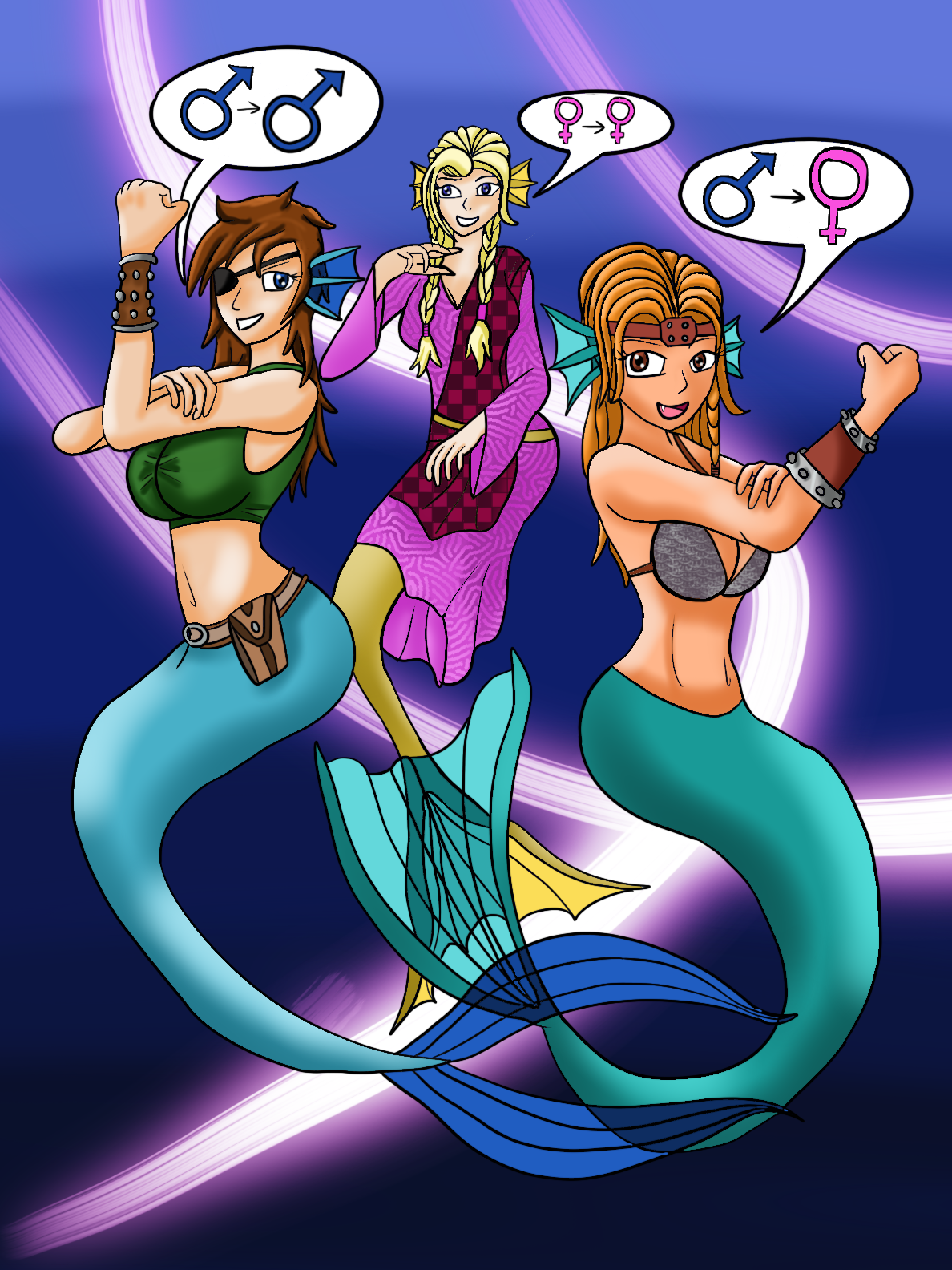
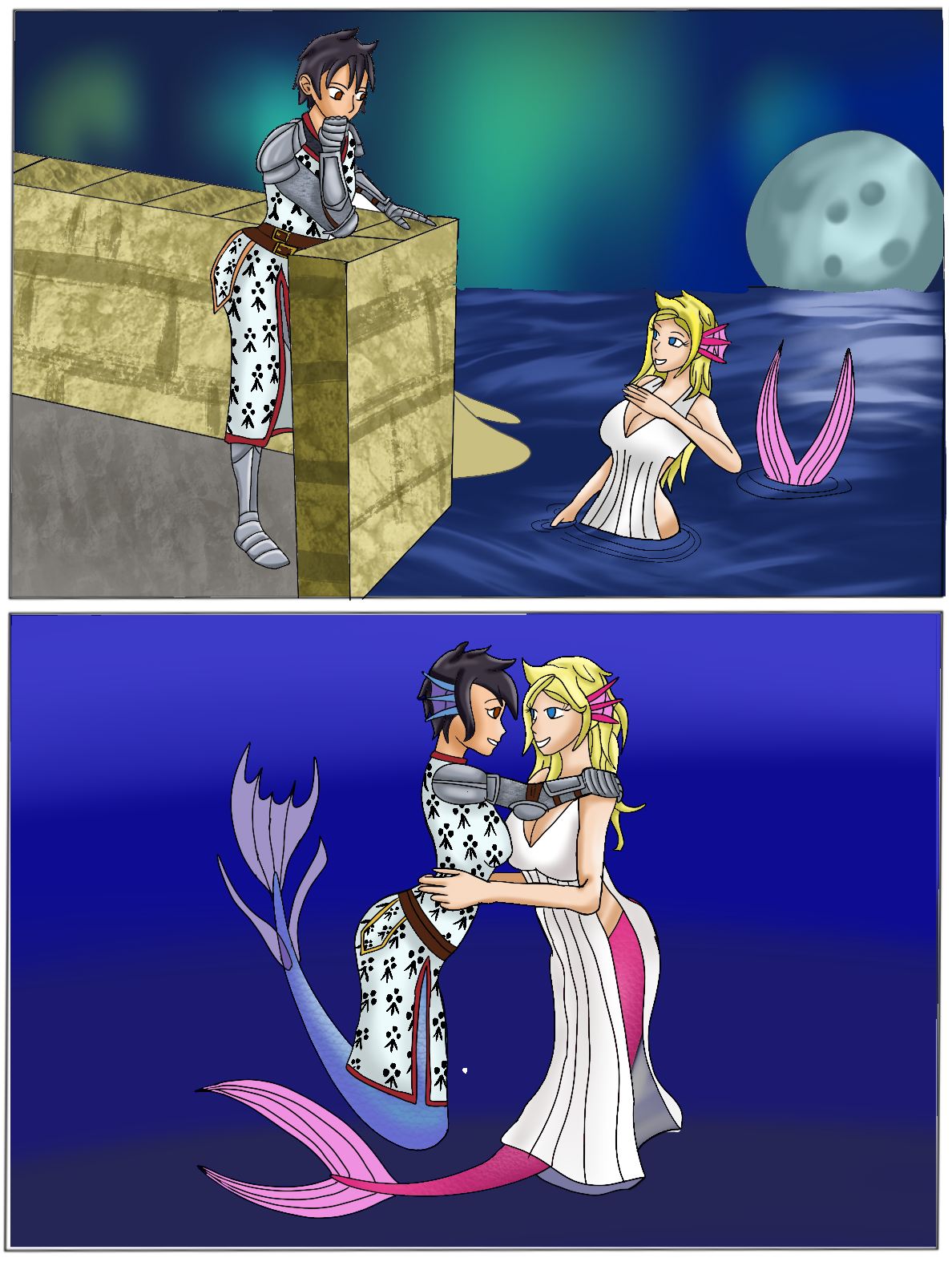
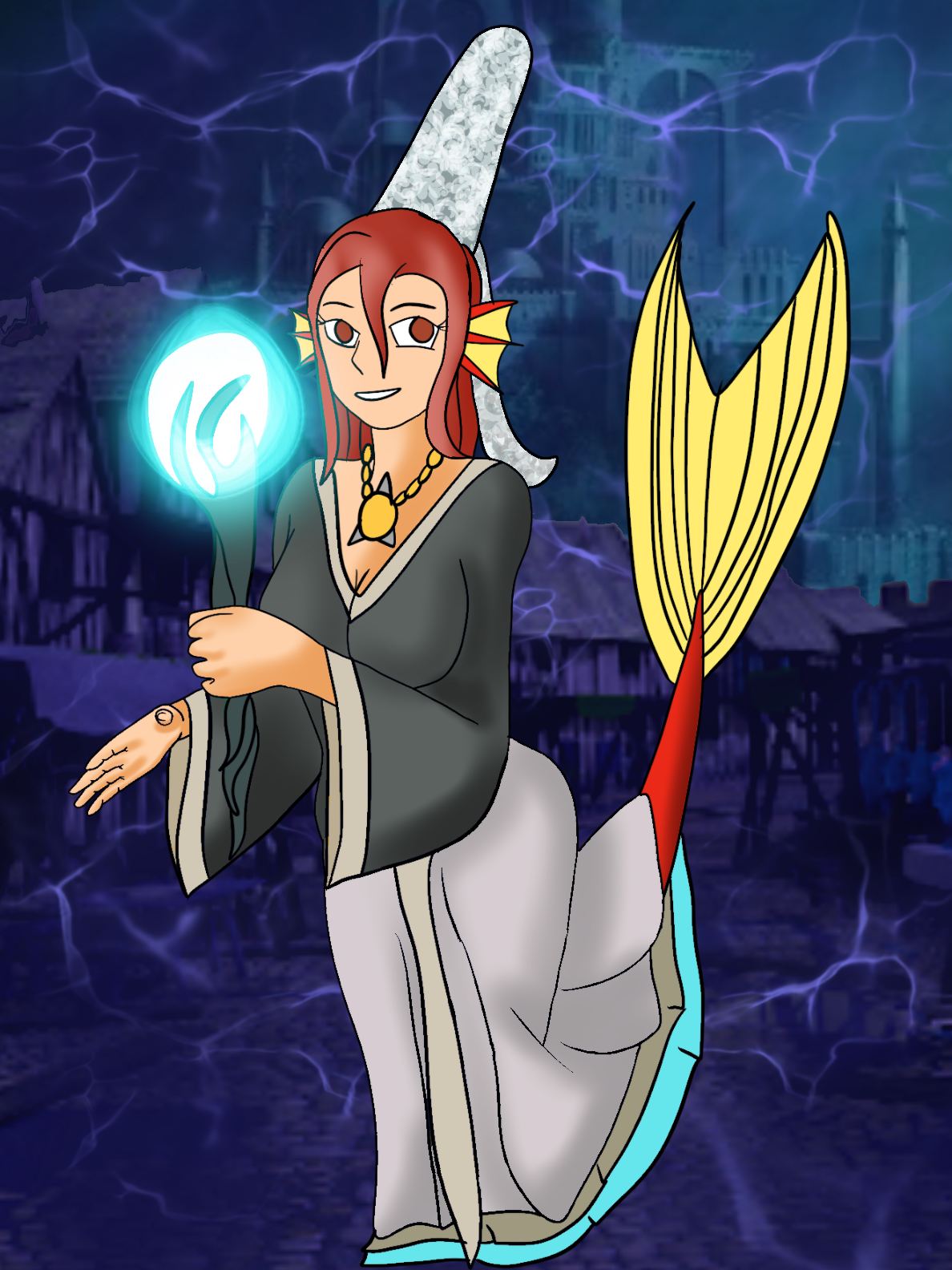

Comments